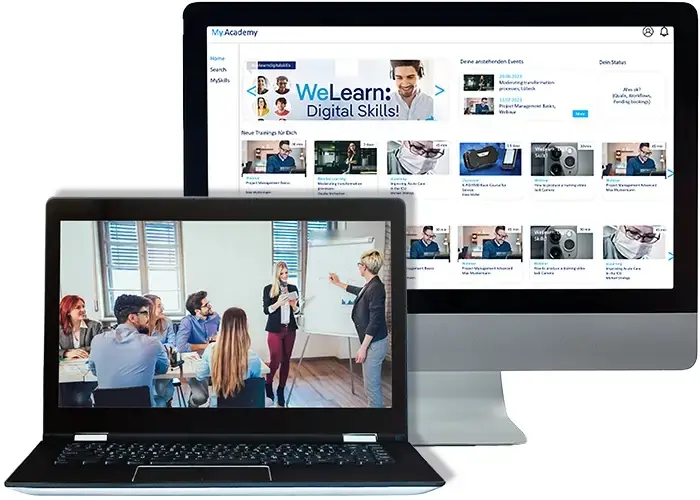Maximize Your Billing Efficiency & Customer Satisfaction with Flexible Billing Options
A modern Learning Management System (LMS) offers comprehensive capabilities for managing and billing training sessions for various target groups – from internal employees to external participants, as well as dealers and service partners.
To meet the needs of these groups, it is essential that the LMS supports flexible billing and payment options that seamlessly integrate with existing processes and accounting systems. This guide provides an overview of the different target groups and the billing methods supported by an LMS.
1. Advantage of an LMS for Different Target Groups
A Learning Management System (LMS) that serves different target groups, such as corporate clients, internal employees, and resellers, offers significant value, for example with regard to flexible billing models:

By combining flexibility, adaptability, and tailored billing models, the LMS provides an efficient and cost-effective solution for diverse target groups.
-
Centralized Platform: All target groups use one platform, saving administrative costs and resources.
-
Customized Content: Training can be tailored to the specific needs of each target group, enabling targeted learning programs.
-
Scalability: The LMS can easily expand to accommodate new target groups without the need for additional systems.
-
Flexible Billing Models: Different billing options (e.g., usage-based fees, subscriptions, or licensing models) can be offered for each group, aligning with their usage and requirements.
-
Role-Based Access and Automation: Targeted access rights and automated processes minimize administrative effort and increase efficiency.
2. Target Groups and Their Requirements for an LMS
Different target groups of a Learning Management System have various requirements regarding payment and billing methods. An LMS must accommodate these needs and provide appropriate solutions.
2.1 Internal Employees
Companies that conduct training for their own employees often use internal cost center accounting. An LMS allows for automatic allocation of training costs to the appropriate department. Additionally, the system can manage training accounts with a set annual budget.
Example: The HR department manages a training budget of 30,000 Euros, from which bookings are directly deducted.
2.2 External Participants (Customers, Attendees)
For external participants, flexibility in payment methods is crucial. An LMS often offers installment payments, making it easier for attendees to pay for expensive training in multiple installments. However, the LMS can only monitor payments if the accounting software provides the necessary information.
Example: A participant books a course for 1,500 Euros and pays in three monthly installments. The LMS monitors payment based on accounting data.
2.3 Corporate Clients
For corporate clients who regularly book training for their employees, an LMS offers both consolidated invoices and discount tiers based on the number of bookings. The LMS can also manage a training account with a set annual budget.
Example: A company that books training for 20 employees per year receives a 20% discount on the 15th booking.
2.4 Service Partners
Service partners benefit from consolidated invoices that combine multiple trainings and participants into a single invoice. Additionally, vouchers and discount tiers can be utilized to make bookings more attractive.
Example: A service partner who books training for ten technicians receives a consolidated invoice and a 10% discount on each training session.
2.5 Dealers and Resellers
Dealers and resellers are often offered discount tiers for their purchases based on the achieved qualification levels.
Example: A dealer who has reached a professional qualification level receives a 10% discount for his future purchases.
3. Billing and Payment Methods in an LMS
A robust Learning Management System supports a variety of billing and payment methods that cater to the different requirements of target groups. These range from traditional invoicing to specialized options like vouchers and installment payments.
3.1 Standard Invoicing
Standard invoicing is one of the most common methods. After booking a training session, the LMS automatically generates an invoice, which can be sent via email or forwarded to the accounting system. Thus, the LMS must provide interfaces for data exchange.
Example: After booking a course, a participant automatically receives an invoice via email.
3.2 Installment Payments
The LMS provides the option to pay for training in multiple installments. To correctly monitor these payments, the LMS requires integration with the accounting software that provides the relevant payment information.
Example: An external customer books a training session and pays the amount in four installments. The LMS monitors the payments and automatically reports any missing installments.
3.3 Consolidated Invoices for Corporate Clients
Consolidated invoices are particularly beneficial for larger companies or service partners booking training for multiple participants simultaneously. The LMS consolidates all bookings into a single invoice, reducing administrative overhead.
Example: A company books five training sessions for 15 employees during the month and receives a consolidated invoice.

3.4 Training Accounts with Annual Budget
Companies can set up training accounts with a fixed annual budget that is managed through the LMS. The LMS monitors expenditures and displays the remaining balance.
Example: A company has a budget of 100,000 Euros for training, which is automatically reduced with each booking.
3.5 Internal Cost Center Accounting
Companies can internally allocate training costs to different cost centers. The LMS automatically assigns the training costs to the appropriate departments.
Example: An IT training is automatically assigned to the IT department and internally accounted for.
3.6 Invoice Delivery and Integration with Financial Systems
The LMS can either send invoices directly or pass them to the financial software via an interface. This automates the entire invoicing process and integrates it seamlessly into accounting.
Example: An invoice for a booked training session is directly sent to the financial software for further processing.
3.7 Integration with Cash Register Systems
Integration with cash register systems allows for payments not only for training fees but also for teaching materials and training resources directly on-site. Cash or card payments can be integrated into the billing process.
Example: Participants of an in-person training pay for their training materials on-site at the cash register, which is linked with the LMS.

3.8 Training Vouchers
Many companies offer training vouchers when to their customers, when they are purchasing products. Those vouchers are processed during the enrolment process within the LMS.
Example: Upon purchasing a machine, a dealer receives a voucher for technical training, which is automatically redeemed when booking the training.
3.9 Vouchers and Discounts for Dealers and Service Partners
The LMS allows for the management of training vouchers and provides discounts based on qualification levels or discount tiers. This feature is especially popular among service partners and dealers.
Example: A dealer receives a 15% discount on future training sessions upon reaching a certain qualification level.
3.10 Online Payment Methods
Modern payment methods such as credit cards, ApplePay, or PayPal can be easily integrated into an LMS. This allows external participants to quickly and securely pay for training online.
Example: An external customer books a seminar and pays directly via PayPal.

3.11 Support for Multiple Currencies and Tax Rates
For international training business, it is crucial that the LMS issues invoices in various currencies. The Learning Management System must also be able to handle different VAT rates for training, materials, and documentation.
Example: A participant from Canada books a training session priced in Euros and pays in Canadian Dollars, with the LMS calculating the exchange rate automatically.
4. The Right Billing Strategy for Your Learning Management System
A versatile billing system in the Learning Management System allows companies to cater specifically to the needs of different customer groups.
For example, corporate clients benefit from consolidated invoices and cost center billing, simplifying administrative processes and increasing internal transparency. External participants appreciate flexible payment options such as installment plans or credit card payments, which lower booking barriers and increase participation rates.
Dealers and partners can be directly tied to the training platform through the integration of discount tiers and qualification levels. The strategic importance lies in the automation of processes: seamless integration with financial systems allows for real-time monitoring of payments, reduces error sources, and optimizes the company's liquidity.

Checklist for Optimal Billing in Your LMS
- Does the LMS support different target groups (internal, external, corporate clients)?
- Are consolidated invoices available for multiple participants and training sessions?
- Does the LMS manage vouchers and discount tiers for dealers and partners?
- Are installment payments and flexible payment plans supported?
- Is internal cost center accounting available?
- Can the LMS monitor payment receipts and manage cancellation invoices and credits?
- Does the LMS integrate with cash register systems and online payment services like PayPal or ApplePay?
- Does the system manage invoices in various currencies for international clients?
With these features, your LMS will ensure that your training processes are efficient and user-friendly.

About Us
Since 1998 SoftDeCC is working closely with major training centers and academies. This results in a unique experience with training requirements.
Our Learning Management System is designed to adjust to individual corporate learning processes and address evolving challenges. More...

Free Consultancy
Discuss your Training Challenge with us.
Call +49 (0)89 / 309083930 to arrange for your free consultancy.
.webp)




